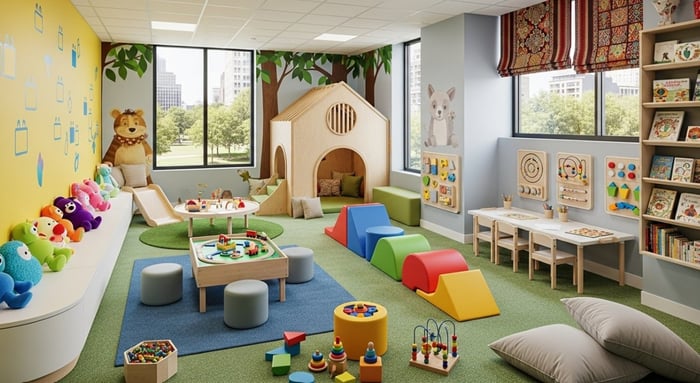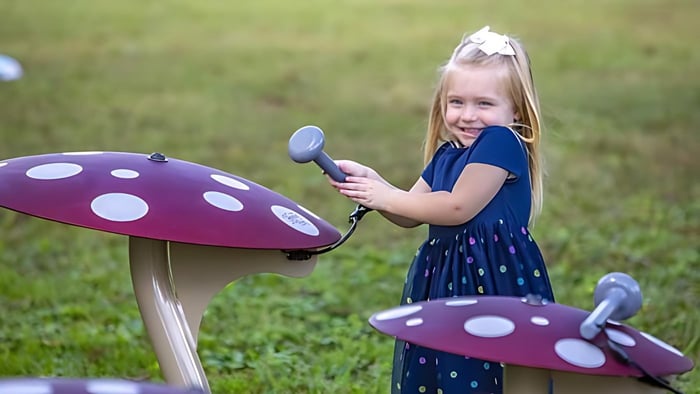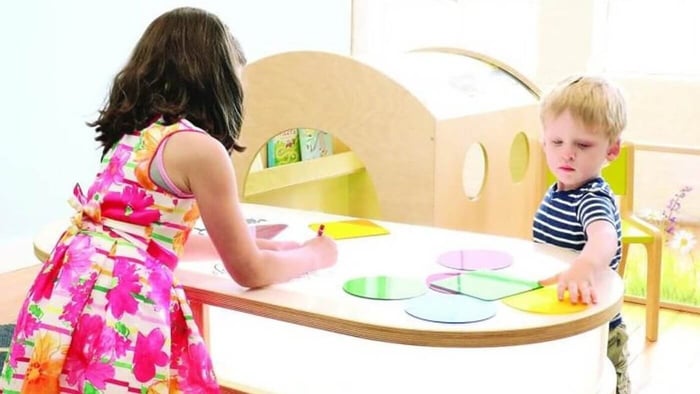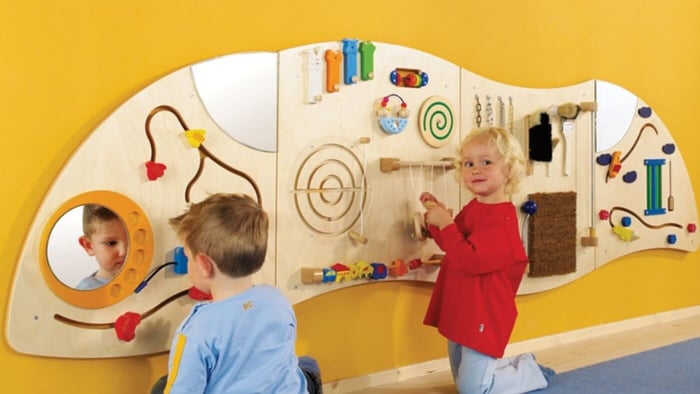
The Benefits of Sensory Wall Panels for Children with Autism
Table of Contents
- Discover how tactile sensory wall panels create structured sensory experiences that help children with autism process information safely. These interactive panels develop fine motor skills, emotional regulation, and cognitive abilities while providing crucial multisensory stimulation for brain development.
- Key Takeaways
- How Sensory Wall Panels Empower Children with Autism
- What Are Sensory Wall Panels?
- Types of Sensory Input
- Mounting & Space Efficiency
- Developmental Benefits for Children with Autism
- Building Cognitive Skills Through Sensory Exploration
- Enhancing Fine Motor Development
- Supporting Communication & Social Development
- Emotional Regulation & Self-Awareness
- Lifelong Benefits of Early Sensory Learning
- Explore Sensory Wall Panels at Little People’s Cove
- FAQs
Discover how tactile sensory wall panels create structured sensory experiences that help children with autism process information safely. These interactive panels develop fine motor skills, emotional regulation, and cognitive abilities while providing crucial multisensory stimulation for brain development.
Key Takeaways
Multisensory stimulation: Panels provide safe, structured sensory input that supports brain development.
Skill-building tools: Panels develop fine motor skills, hand-eye coordination, and cognitive abilities.
Autism-friendly design: Little People's Cove offers panels designed to create calming, predictable sensory experiences.
Emotional support: These panels aid sensory regulation and reduce overwhelm in stimulating environments.
Communication & connection: Regular use can strengthen communication skills, joint attention, and emotional resilience.
Sensory Learning Wall 3-Piece Set
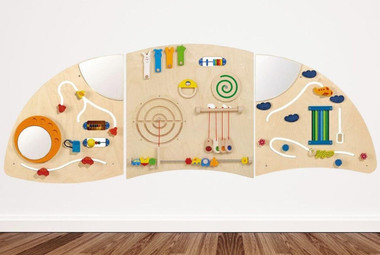
$2,156.36
Commercial-Grade HABA Sensory Learning Wall - 3-Piece Set - Built for Tactile Play, Sensory Development & Independent Exploration This three-panel sensory wall set offers a...… read more
How Sensory Wall Panels Empower Children with Autism
For children on the autism spectrum, the world can feel chaotic and unpredictable. Sensory wall panels help bring order and calm by offering a sensory-rich experience in a predictable and non-threatening format. These interactive panels create safe opportunities for exploration, giving children the freedom to engage with their environment at their own pace.
">At Little People’s Cove, we provide purposefully designed wall panels that create structured, sensory-safe spaces—perfect for therapy rooms, classrooms, waiting areas, and homes.
What Are Sensory Wall Panels?
✅ Design Features & Materials
Sensory wall panels are interactive installations that engage multiple senses through:
Textures: Soft, bumpy, rough, smooth, rubbery, or wooden elements
Shapes & colors: Visually stimulating patterns and contrasting hues
Movement: Sliders, gears, knobs, and rotating parts
Sounds: Bells, chimes, or buttons with audio feedback
All materials are child-safe and durable, crafted to endure regular use while providing reliable sensory feedback.
Types of Sensory Input
These panels combine a variety of sensory components:
Touch: Varied surfaces that offer different sensations
Sight: Bright colors, mirror elements, visual tracking paths
Sound: Interactive audio feedback through buttons or chimes
Advanced panels may also include puzzles, matching activities, and cause-and-effect mechanisms to promote learning through play.
Mounting & Space Efficiency
Sensory panels are typically mounted on walls, saving valuable floor space. Common installation methods include:
Wall-mounted units
Modular systems
Corner and free-standing options
This vertical design encourages children to stand and engage, promoting better posture and core strength.
Motor Skills E Sensory Learning Wall Toy
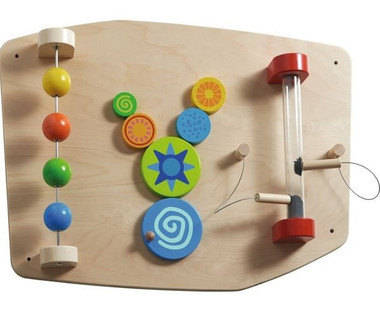
$765.16
HABA Sensory Learning Wall Toy - Motor Skills E - Explore Motion, Color & Sensation This rich sensory panel brings interactive learning and discovery to...… read more
Developmental Benefits for Children with Autism
1. Sensory Regulation & Integration
Children with autism may be hypersensitive or hyposensitive to sensory input. These panels provide a safe, controlled environment to explore sensations at their comfort level—helping them integrate sensory experiences without becoming overwhelmed.
2. Predictability & Routine
Consistency is key. Wall-mounted panels stay in the same place, offering children a reliable, familiar tool they can return to for comfort and regulation.
3. Creating Sensory-Safe Spaces
Ideal for quiet zones in classrooms or therapy spaces, panels offer a calming retreat from overstimulating environments.
Building Cognitive Skills Through Sensory Exploration
Problem-Solving & Cause-and-Effect
Interactive elements help children discover how their actions lead to outcomes, reinforcing flexible thinking and problem-solving.
Pattern Recognition & Sequencing
Panels with sorting and matching activities support visual discrimination, sequencing, and memory—common strengths in children with autism.
Enhancing Fine Motor Development
✋ Dexterity & Grip Strength
Using knobs, levers, sliders, and buttons helps strengthen:
Pincer grasp
Finger isolation
Bilateral coordination
Wrist rotation
These improvements support everyday tasks like writing, dressing, and eating.
Hand-Eye Coordination
Activities that involve tracking and movement build neural connections between visual and motor functions, boosting coordination and confidence.
Practical Skill Transfer
Motor skill improvements carry over into daily life—empowering children to use utensils, zip coats, and handle small tools independently.
Playsa Face Boy & Girl Heat Sensitive Wall Panels
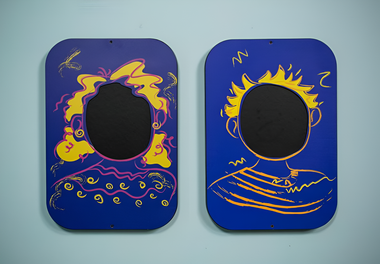
$565.11
Playsa Face Boy & Girl Heat‑Sensitive Wall Panels - Mess‑Free Drawing Fun for Kids Drawing just got a lot easier (and a lot less messy)!...… read more
Supporting Communication & Social Development
Vocabulary & Language Growth
Descriptive play encourages children to express preferences, describe actions, and name objects—supporting vocabulary and expressive language skills.
For non-verbal children, panels provide a platform for alternative communication through gestures, signs, or assistive systems.
Promoting Joint Attention
Panels act as shared focal points, naturally encouraging turn-taking, modeling, and interaction with peers or adults.
Non-Verbal Communication
Repeated engagement reveals preferences, helping caregivers understand each child's unique sensory profile and communication style.
Emotional Regulation & Self-Awareness
Calming Sensory Input
Certain panel features, like rhythmic movement or consistent feedback, help calm the nervous system and support emotional regulation.
Sensory Break Opportunities
Panels provide opportunities for self-directed breaks, helping children reset, regulate, and return to tasks more focused and balanced.
Learning Self-Awareness
Over time, children learn which inputs help them feel calm or alert—building personal strategies for emotional regulation.
Lifelong Benefits of Early Sensory Learning
Sensory wall panels do more than entertain—they lay a foundation for independence, emotional well-being, and adaptive thinking.
From therapy centers to classrooms to home play areas, these panels are powerful tools that help children with autism thrive, connect, and grow with confidence.
Explore Sensory Wall Panels at Little People’s Cove
At Little People's Cove, we offer a thoughtfully curated selection of high-quality sensory wall panels designed to support children with autism. Whether you're creating a calm-down corner, therapy zone, or sensory-friendly classroom, our panels offer the structure and stimulation children need for meaningful development.
👉 Browse our collection: Sensory Wall Panels
FAQs
What are the benefits of sensory wall panels for children with autism?
Sensory wall panels offer multiple advantages for children with autism: they reduce anxiety and sensory overload, promote focus, and support self-regulation. These panels deliver a controlled multisensory experience—combining tactile textures, calming visuals, and gentle auditory input—to help improve sensory processing and emotional well-being.
How do sensory wall panels aid motor and cognitive development in autistic children?
Tactile and interactive wall panels help develop both fine and gross motor skills through climbing, touching, and manipulating features like buttons, fidget tools, and movable parts. They also enhance coordination, concentration, and cognitive engagement, as children focus on exploring textures, visual patterns, and auditory elements.
Why are sensory walls particularly supportive for children with autism in schools or therapies?
Sensory wall panels offer a safe, customizable environment where children can explore at their own pace, making them excellent tools for self-regulation and emotional de-escalation. They support individualized sensory needs—whether calming or stimulating—and encourage independent exploration while maintaining structure and predictability.

